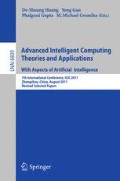Abstract
In this paper a new hybrid method has been proposed for solving the suspension design problem. A two-dimensional model of a car with linear passive suspension system and with two passengers has been considered. The vibration, experienced by the passengers due to road bump during vehicle motion has been minimized in time domain, by applying the proposed method. Moreover, the suspension parameters have been determined which satisfy performance as per ISO standards. The solutions/ parametric values so obtained have been further compared with the existing suspension parameters.
Access this chapter
Tax calculation will be finalised at checkout
Purchases are for personal use only
Preview
Unable to display preview. Download preview PDF.
References
Shieh, N.-C., Lin, C.-L., Lin, Y.-C., Liang, K.-Z.: Optimal Design for Passive Suspension of A Light Rail Vehicle Using Constrained Multiobjective Evolutionary Search. J. Sound Vibr. 285, 407–424 (2005)
Baumal, A.E., McPhee, J.J., Calamai, P.H.: Application of Genetic Algorithms to the Design Optimization of An Active Vehicle Suspension System. Comp. Meth. Appl. Mech. Engrg. 163, 87–94 (1998)
Deb, K., Saxena, V.: Car Suspension Design for Comfort Using Genetic Algorithms. In: Back, T. (ed.) Proceedings of Seventh International Conference in Genetic Algorithm, pp. 553–560 (1997)
Sun, L., Cai, X., Yang, J.: Genetic Algorithm-based Optimum Vehicle Suspension Design Using Minimum Dynamic Pavement Load as A Design Criterion. J. Sound Vibr. 301, 18–27 (2007)
Taghirad, H.D., Esmailzadeh, E.: Automobile Passenger Comfort Assured through LQR/ LQR Active Suspension. J. Vibr. Cont. 4(5), 603–618 (1998)
Gillespie, T.D.: Fundamentals of Vehicle Dynamics. Society of Automotive Engineers, Warrendale (2003)
Griffin, M.J.: Handbook of Human Vibration. Academic Press, London (2003)
Jabeen, S.D., Bhunia, A.K.: Real-coded Genetic Algorithm with Variable Rates of Cross-over and Mutation: A Basis of Global Optimization via Interval Technique. Int. J. Comp. Math. 83(12), 853–866 (2006)
International Organization for standardization (ISO), 2631-1 (E). Mechanical vibration and shock-Evaluation of human exposure to whole-body vibration. Part 1: General requirements
Author information
Authors and Affiliations
Editor information
Editors and Affiliations
Rights and permissions
Copyright information
© 2012 Springer-Verlag Berlin Heidelberg
About this paper
Cite this paper
Jabeen, S.D., Mukherjee, R.N. (2012). Vibration Control of a Vehicle Using Hybrid Genetic Algorithm. In: Huang, DS., Gan, Y., Gupta, P., Gromiha, M.M. (eds) Advanced Intelligent Computing Theories and Applications. With Aspects of Artificial Intelligence. ICIC 2011. Lecture Notes in Computer Science(), vol 6839. Springer, Berlin, Heidelberg. https://doi.org/10.1007/978-3-642-25944-9_16
Download citation
DOI: https://doi.org/10.1007/978-3-642-25944-9_16
Publisher Name: Springer, Berlin, Heidelberg
Print ISBN: 978-3-642-25943-2
Online ISBN: 978-3-642-25944-9
eBook Packages: Computer ScienceComputer Science (R0)

